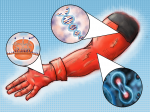Friday will mark the return of millennials’ favorite antihero.
Guns blazing and swords flashing, Wade Wilson – better known as Deadpool (Ryan Reynolds) – will take the big screen alongside his X-Men friends and a beloved taxi driver. In the film, Deadpool’s regenerative abilities are considered miraculous, but science actually played an important role in creating the foul-mouthed mercenary. Upon further research into the topic, I learned that even though his regenerative abilities are not possible in humans, they aren’t completely fictional.
The first installment of the series shows Wade agreeing to a secret, illegal experiment that could potentially cure him of cancer. Upon receiving the “treatment,” the scientist administering it forces Wade into a chamber where he is deprived of oxygen. The captivity eventually causes the activation of his latent mutant abilities to recover from any injury and the scarring of his tissue. After a series of altercations, the facility blows up and Wade is impaled with rebar while the villain scientist who conducted the experiment escapes. However, once the explosions die down, we see Wade resurrecting and detaching himself from the metal bar as the hole in his body disappears.
No research thus far has demonstrated that oxygen deprivation can catalyze special abilities or cause tissue scarring. Rather, oxygen deprivation causes cyanosis, a blue-tinged appearance of the skin, which is quickly reverted when oxygenated blood flow resumes. However, oxygen deprivation can activate certain genes, including those responsible for creating hormones to promote growth, through proteins called hypoxia-inducible factors.
As for Deadpool’s ability to effortlessly regrow a missing arm, both science and science fiction accurately state its origin in cancer, which is linked to regeneration. In cancer-linked regeneration, the body tries to find a balance between expressing tumor-suppressing genes and proto-oncogenes – normal genes that, if mutated, contribute to cancer development. Depending on which genes are activated, the cells and tissues in the body can either grow rapidly or not grow at all.
If one is to go by what science dictates, Deadpool’s proto-oncogene expression increases dramatically when he is injured, promoting increased cell division and growth. When he isn’t hurt, one can assume his body instead activates tumor-suppressor genes to decrease cell division and growth.
Currently, researchers are investigating what genes and proteins can make average humans similar to Deadpool in terms of regenerative abilities. One possible candidate is Lin28a, which reprograms tissues, and infuses them with stem-cell characteristics, or the ability to turn into any type of cell. When activated in mice, the gene allowed the regrowth of lost hair, ears and toes. Whether or not Deadpool actually utilizes Lin28a is unknown, but it’s safe to say that some undiscovered genes in his body are definitely promoting regeneration.
Seeing a real-life Deadpool walk around Hollywood is impossible at the moment, but seeing his incredible abilities in action isn’t. The axolotl, a type of salamander, can perfectly regrow any damaged body part, including cut limbs, tails or even damaged brain tissue. When the spinal cord is severed, the salamander can still revert to its fully functional form without any type of scarring. Researchers have theorized that the amphibian’s regeneration mechanism involves changing the balance between expression of proto-oncogenes and tumor-suppressor genes, citing the proto-oncogene c-ski as a possible candidate because of its role in cell proliferation and muscle development.
Since Deadpool’s anatomical composition is unknown, we might never find out what genes his body is actively suppressing or promoting. Researchers have made some headway, albeit slowly, in discovering genes responsible for regeneration. But in the meantime, we’ll just have to rely on research that’s still in the works.
